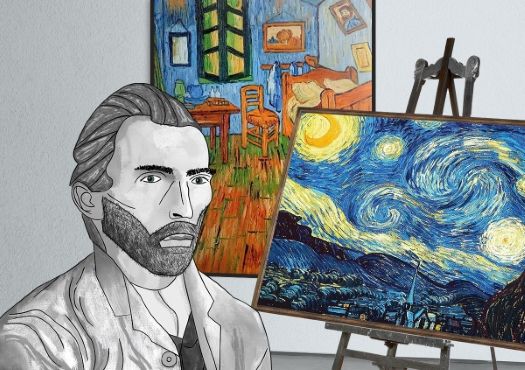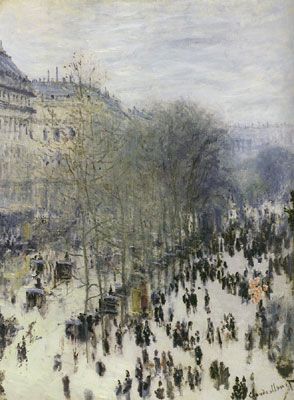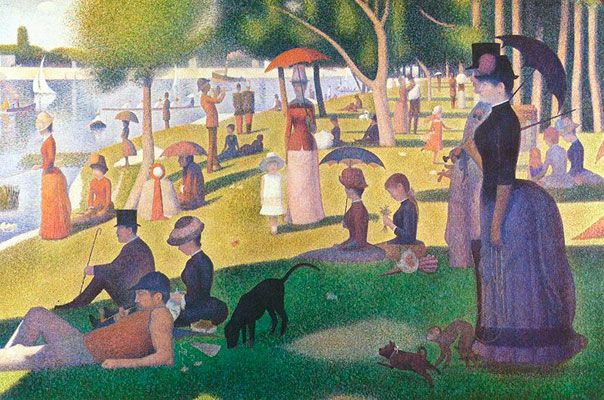Summary of Vincent van Gogh
The iconic tortured artist, Vincent Van Gogh strove to convey his emotional and spiritual state in each of his artworks. Although he sold only one painting during his lifetime, Van Gogh is now one of the most popular artists of all time. His canvases with densely laden, visible brushstrokes rendered in a bright, opulent palette emphasize Van Gogh's personal expression brought to life in paint. Each painting provides a direct sense of how the artist viewed each scene, interpreted through his eyes, mind, and heart. This radically idiosyncratic, emotionally evocative style has continued to affect artists and movements throughout the 20th century and up to the present day, guaranteeing Van Gogh's importance far into the future.
Accomplishments
- Van Gogh's dedication to articulating the inner spirituality of man and nature led to a fusion of style and content that resulted in dramatic, imaginative, rhythmic, and emotional canvases that convey far more than the mere appearance of the subject.
- Although the source of much upset during his life, Van Gogh's mental instability provided the frenzied source for the emotional renderings of his surroundings and imbued each image with a deeper psychological reflection and resonance.
- Van Gogh's unstable personal temperament became synonymous with the romantic image of the tortured artist. His self-destructive talent was echoed in the lives of many artists in the 20th century.
- Van Gogh used an impulsive, gestural application of paint and symbolic colors to express subjective emotions. These methods and practice came to define many subsequent modern movements from Fauvism to Abstract Expressionism.
The Life of Vincent van Gogh
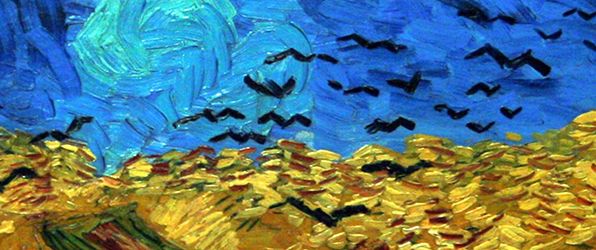
Vincent expressed his life via his works. As he famously said, "real painters do not paint things as they are... they paint them as they themselves feel them to be."
Important Art by Vincent van Gogh
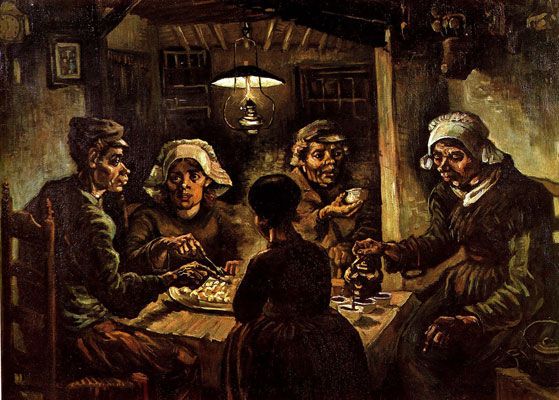
The Potato Eaters
This early canvas is considered Van Gogh's first masterpiece. Painted while living among the peasants and laborers in Nuenen in the Netherlands, Van Gogh strove to depict the people and their lives truthfully. Rendering the scene in a dull palette, he echoed the drab living conditions of the peasants and used ugly models to further iterate the effects manual labor had upon these workers. This effect is heightened by his use of loose brushstrokes to describe the faces and hands of the peasants as they huddle around the singular, small lantern, eating their meager meal of potatoes. Despite the evocative nature of the scene, the painting was not considered successful until after Van Gogh's death. At the time this work was painted, the Impressionists had dominated the Parisian avant-garde for over a decade with their light palettes. It is not surprising that Van Gogh's brother, Theo, found it impossible to sell paintings from this period in his brother's career. However, this work not only demonstrates Van Gogh's commitment to rendering emotionally and spiritually laden scenes in his art, but also established ideas that Van Gogh followed throughout his career.
Oil on canvas - The Van Gogh Museum, Amsterdam
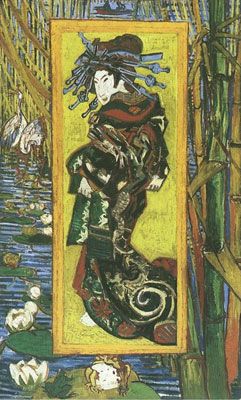
The Courtesan (after Eisen)
While in Paris, Van Gogh was exposed to a myriad of artistic styles, including the Japanese Ukiyo-e woodblock prints. These prints were only made available in the West in the mid-19th century. Van Gogh collected works by Japanese ukiyo-e masters like Hiroshige and Hokusai and claimed these works were as important as works by European artists, like Rubens and Rembrandt. Van Gogh was inspired to create this particular painting by a reproduction of a print by Keisai Eisen that appeared on the May 1886 cover of the magazine Paris Illustré. Van Gogh enlarges Eisen's image of the courtesan, placing her in a contrasting, golden background bordered by a lush water garden based on the landscapes of other prints he owned. This particular garden is populated by frogs and cranes, both of which were allusions to prostitutes in French slang. While the stylistic features exhibited in this painting, in particular the strong, dark outlines and bright swaths of color, came to define Van Gogh's mature style, he also made the work his own. By working in paint rather than a woodblock print, Van Gogh was able to soften the work, relying on visible brushstrokes to lend dimension to the figure and her surroundings as well as creating a dynamic tension across the surface not present in the original prints.
Oil on canvas - The Van Gogh Museum, Amsterdam
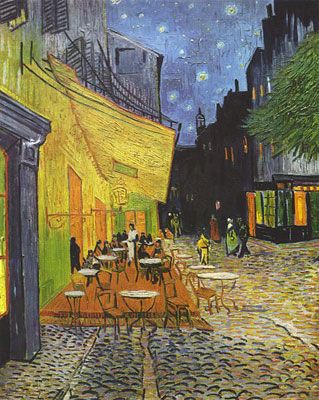
Café Terrace At Night
This was one of the scenes Van Gogh painted during his stay in Arles and a painting where he used his powerful nocturnal background. Using contrasting colors and tones, Van Gogh achieved a luminous surface that pulses with an interior light, almost in defiance of the darkening sky. The lines of composition all point to the center of the work drawing the eye along the pavement as if the viewer is strolling the cobblestone streets. The café still exists today and is a "mecca" for van Gogh fans visiting the south of France. Describing this painting in a letter to his sister he wrote, "Here you have a night painting without black, with nothing but beautiful blue and violet and green and in this surrounding the illuminated area colors itself sulfur pale yellow and citron green. It amuses me enormously to paint the night right on the spot..." Painted on the street at night, Van Gogh recreated the setting directly from his observations, a practice inherited from the Impressionists. However, unlike the Impressionists, he did not record the scene merely as his eye observed it, but imbued the image with a spiritual and psychological tone that echoed his individual and personal reaction. The brushstrokes vibrate with the sense of excitement and pleasure Van Gogh experienced while painting this work.
Oil on canvas - Kröller-Muller Museum, Otterlo
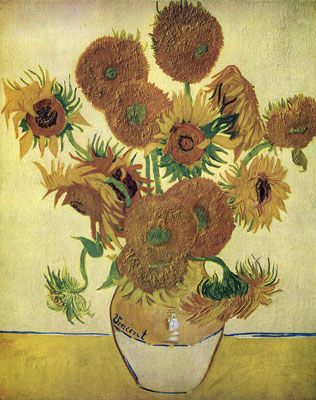
Sunflowers
Van Gogh's Sunflower series was intended to decorate the room that was set aside for Gauguin at the "Yellow House," his studio and apartment in Arles. The lush brushstrokes built up the texture of the sunflowers and Van Gogh employed a wide spectrum of yellows to describe the blossoms, due in part to recently invented pigments that made new colors and tonal nuances possible. Van Gogh used the sunny hues to express the entire lifespan of the flowers, from the full bloom in bright yellow to the wilting and dying blossoms rendered in melancholy ochre. The traditional painting of a vase of flowers is given new life through Van Gogh's experimentation with line and texture, infusing each sunflower with the fleeting nature of life, the brightness of the Provencal summer sun, as well as the artist's mindset.
Oil on canvas - The National Gallery, London
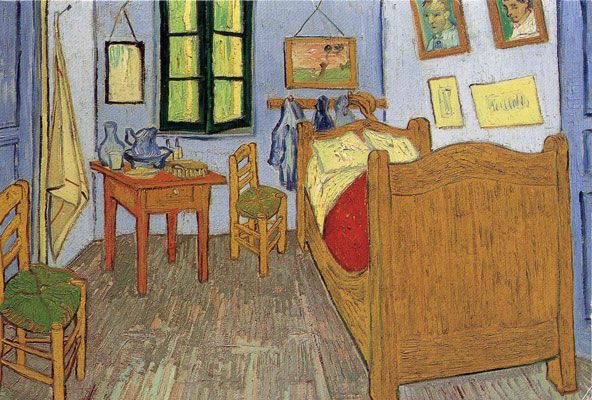
The Bedroom
Van Gogh's Bedroom depicts his living quarters at 2 Place Lamartine, Arles, known as the "Yellow House". It is one of his most well known images. His use of bold and vibrant colors to depict the off-kilter perspective of his room demonstrated his liberation from the muted palette and realistic renderings of the Dutch artistic tradition, as well as the pastels commonly used by the Impressionists. He labored over the subject matter, colors, and arrangements of this composition, writing many letters to Theo about it, "This time it's just simply my bedroom, only here color is to do everything, and giving by its simplification a grander style to things, is to be suggestive here of rest or of sleep in general. In a word, looking at the picture ought to rest the brain, or rather the imagination." While the bright yellows and blues might at first seem to echo a sense of disquiet, the bright hues call to mind a sunny summer day, evoking as sense of warmth and calm, as Van Gogh intended. This personal interpretation of a scene in which particular emotions and memories drive the composition and palette is a major contribution to modernist painting.
Oil on canvas - The Van Gogh Museum, Amsterdam
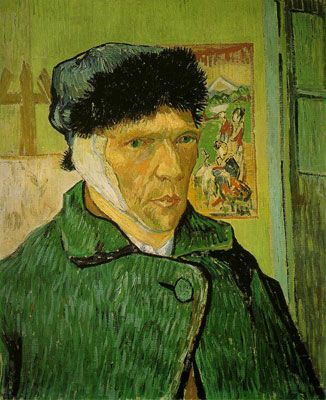
Self-Portrait with Bandaged Ear
After cutting off a portion of his left earlobe during a manic episode while in Arles, Van Gogh painted Self Portrait with a Bandaged Ear while recuperating and reflecting on his illness. He believed that the act of painting would help restore balance to his life, demonstrating the important role that artistic creation held for him. The painting bears witness to the artist's renewed strength and control in his art, as the composition is rendered with uncharacteristic realism, where all his facial features are clearly modeled and careful attention is given to contrasting textures of skin, cloth, and wood. The artist depicts himself in front of an easel with a canvas that is largely blank and a Japanese print hung on the wall. The loose and expressive brushstrokes typical of Van Gogh are clearly visible; the marks are both choppy and sinuous, at times becoming soft and diffuse, creating a tension between boundaries that are otherwise clearly marked. The strong outlines of his coat and hat mimic the linear quality of the Japanese print behind the artist. At the same time, Van Gogh deployed the technique of impasto, or the continual layering of wet paint, to develop a richly textured surface, which furthers the depth and emotive force of the canvas. This self-portrait, one of many Van Gogh created during his career, has an intensity unparalleled in its time, which is elucidated in the frank manner in which the artist portrays his self-inflicted wound as well as the evocative way he renders the scene. By combining influences as diverse as the loose brushwork of the Impressionists and the strong outlines from Japanese woodblock printing, Van Gogh arrived at a truly unique mode of expression in his paintings.
Oil on canvas - The Courtauld Gallery, London
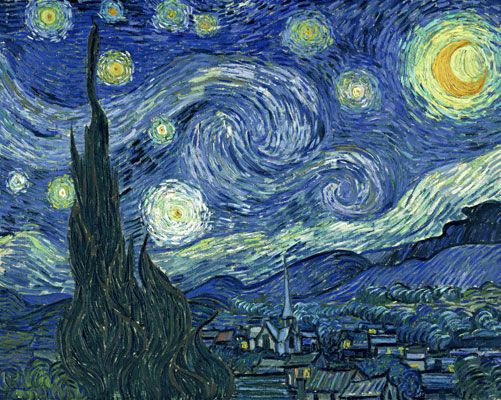
Starry Night
Starry Night is often considered to be Van Gogh's pinnacle achievement. Unlike most of his works, Starry Night was painted from memory, and not out in the landscape. The emphasis on interior, emotional life is clear in his swirling, tumultuous depiction of the sky - a radical departure from his previous, more naturalistic landscapes. Here, Van Gogh followed a strict principal of structure and composition in which the forms are distributed across the surface of the canvas in an exact order to create balance and tension amidst the swirling torsion of the cypress trees and the night sky. The result is a landscape rendered through curves and lines, its seeming chaos subverted by a rigorous formal arrangement. Evocative of the spirituality Van Gogh found in nature, Starry Night is famous for advancing the act of painting beyond the representation of the physical world.
Oil on canvas - The Museum of Modern Art, New York
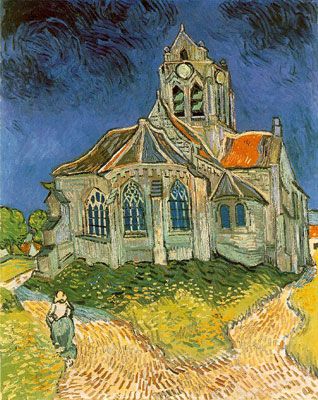
Church at Auvers
After Van Gogh left the asylum at Saint-Remy in May 1890 he travelled north to Auvers, outside of Paris. Church at Auvers is one of the most well-known images from the last few months of Van Gogh's life. Imbuing the landscape with movement and emotion, he rendered the scene with a palette of vividly contrasting colors and brushstrokes that lead the viewer through painting. Van Gogh distorted and flattened out the architecture of the church and depicted it caught within its own shadow - which reflects his own complex relationship to spirituality and religion. Van Gogh conveys a sense that true spirituality is found in nature, not in the buildings of man. The continued influence of Japanese woodblock printing is clear in the thick dark outlines and the flat swaths of color of the roofs and landscape, while the visible brushstrokes of the Impressionists are elongated and emphasized. The use of the acidic tones and the darkness of the church alludes to the impending mental disquiet that would eventually erupt within Van Gogh and lead to his suicide. This sense of instability plagued Van Gogh throughout his life, infusing his works with a unique blend of charm and tension.
Oil on canvas - Musée d'Orsay, Paris
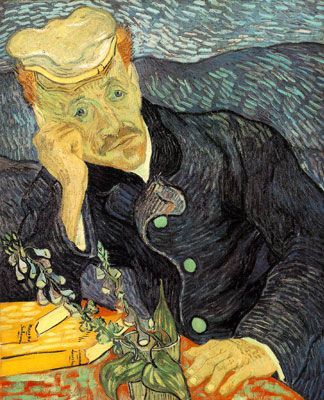
Paul-Ferdinand Gachet
Dr. Gachet was the homeopathic physician that treated Van Gogh after he was released from Saint-Remy. In the doctor, the artist found a personal connection, writing to his sister, "I have found a true friend in Dr. Gachet, something like another brother, so much do we resemble each other physically and also mentally." Van Gogh depicts Gachet seated at a red table, with two yellow books and foxglove in a vase near his elbow. The doctor gazes past the viewer, his eyes communicating a sense of inner sadness that reflects not only the doctor's state of mind, but Van Gogh's as well. Van Gogh focused the viewer's attention on the depiction of the doctor's expression by surrounding his face with the subtly varied blues of his jacket and the hills of the background. Van Gogh wrote to Gauguin that he desired to create a truly modern portrait, one that captured the "the heartbroken expression of our time." Rendering Gachet's expression through a blend of melancholy and gentility, Van Gogh created a portrait that has resonated with viewers since its creation. A recent owner, Ryoei Saito, even claimed he planned to have the painting cremated with him after his death, as he was so moved by the image. The intensity of emotion that Van Gogh poured into each brushstroke is what has made his work so compelling to viewers over the decades, inspiring countless artists and individuals.
Oil on canvas - Private Collection
Biography of Vincent van Gogh
Childhood
Vincent Van Gogh was born the second of six children into a religious Dutch Reformed Church family in the south of the Netherlands. His father, Theodorus Van Gogh, was a clergyman and his mother, Anna Cornelia Carbentus, was the daughter of a bookseller. Van Gogh exhibited unstable moods during his childhood, and showed no early inclination toward art-making, though he excelled at languages while attending two boarding schools. In 1868, he abandoned his studies and never successfully returned to formal schooling.
Early Training
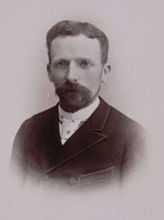
In 1869, Van Gogh apprenticed at the headquarters of the international art dealers Goupil & Cie in Paris and eventually worked at the Hague branch of the firm. He was relatively successful as an art dealer and stayed with the firm for almost a decade. In 1872, Van Gogh began exchanging letters with his younger brother Theo. This correspondence continued through the end of Vincent's life. The following year, Theo himself became an art dealer, and Vincent was transferred to the London office of Goupil & Cie. Around this time, Vincent became depressed and turned to God.
After several transfers between London and Paris, Van Gogh was let go from his position at Goupil's and decided to pursue a life in the clergy. While living in southern Belgium as a poor preacher, he gave away his possessions to the local coal-miners until the church dismissed him because of his overly enthusiastic commitment to his faith. In 1880, Van Gogh decided he could be an artist and still remain in God's service, writing, "To try to understand the real significance of what the great artists, the serious masters, tell us in their masterpieces, that leads to God; one man wrote or told it in a book; another, in a picture." Van Gogh was still a pauper, but Theo sent him some money for survival. Theo financially supported his elder brother his entire career, as Vincent made virtually no money from making art.
A year later, in 1881, dire poverty motivated Van Gogh to move back home with his parents, where he taught himself to draw. He became infatuated with his cousin, Kee Vos-Stricker. His continued pursuit of her affection, despite utter rejection, eventually split the family. With the support of Theo, Van Gogh moved to the Hague, rented a studio, and studied under Anton Mauve - a leading member of the Hague School. Mauve introduced Van Gogh to the work of the French painter Jean-François Millet, who was renowned for depicting common laborers and peasants.
In January 1882, while wandering the streets of The Hague, Van Gogh encountered a young prostitute (who also worked as a seamstress and housecleaner) by the name of Clasina Maria Hoornik. He soon came to refer to her as Christien, which he then shortened to, simply, Sien. She was destitute, addicted to alcohol, pregnant, and had her five year-old daughter Maria Wilhelmina, in tow. Van Gogh took pity on her, and took her into his care for the next year and a half. This dismayed his friends and family, and some of his patrons and benefactors, including his cousin-in-law Anton Mauve, and art dealer Hermanus Tersteeg, abruptly withdrew their support for him.
While Sien's account of their relationship portrays it as one merely of convenience and benevolence, it seems that Van Gogh felt more of a connection, and even had plans to marry her. In return for his support, Sien (as well as her children and mother) modeled for over fifty of Van Gogh's works, such as his 1882 drawing Sorrow, in which Sien appears pregnant, and which the artist once called "the best figure I've drawn". It seems, however, that what Van Gogh valued about her was the challenging life she had faced (she had during her life, become pregnant four different times by four different men, all of whom had abandoned her, and two of the children had died during infancy). He once referred to her as "pockmarked" and "no longer beautiful”, and often depicted her frowning, and in difficult or unflattering situations. Sien and her family also appeared in Van Gogh’s 1883 series The Public Soup Kitchen.
Mature Period
In 1884, after moving to Nuenen, Netherlands, Van Gogh began drawing the weathered hands, heads, and other anatomical features of workers and the poor, determined to become a painter of peasant life like Millet. Although he found a professional calling, his personal life was in shambles. Van Gogh accused Theo of not trying hard enough to sell his paintings, to which Theo replied that Vincent's dark palette was out of vogue compared to the bold and bright style of the Impressionist artists that was popular. Suddenly, on March 26, 1885, their father died from a stroke, putting pressure on Van Gogh to have a successful career. Shortly afterward, he completed the Potato Eaters (1885), his first large-scale composition and great work.
Leaving the Netherlands for the last time, in 1885 Van Gogh enrolled at the Academy of Fine Arts in Antwerp. There he discovered the art of Baroque painter Peter Paul Rubens, whose swirling forms and loose brushwork had a clear impact on the young artist's style. However, the rigidity of academicism of the school did not appeal to Van Gogh and he left for Paris the following year. He moved in with Theo in Montmartre - the artist's district in northern Paris - and studied with painter Fernand Cormon, who introduced the young artist to the Impressionists. The influence of artists such as Claude Monet, Camille Pissarro, Edgar Degas, and Georges Seurat, as well as pressure from Theo to sell paintings, motivated Van Gogh to adopt a lighter palette.
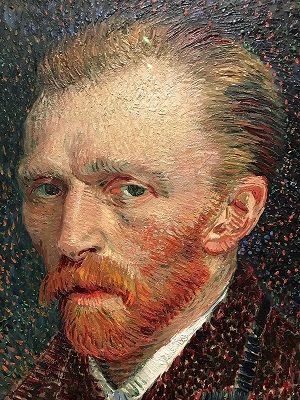
From 1886 to 1888, Van Gogh became acutely interested in Japanese prints and began to avidly study and collect them, even curating an exhibition of them at a Parisian restaurant. In late 1887, Van Gogh organized an exhibition that included his work and that of his colleagues Emile Bernard and Henri de Toulouse-Lautrec, and in early 1888, he exhibited with the Neo-impressionists Georges Seurat and Paul Signac at the Salle de Repetition of the Theatre Libre d'Antoine.
Late Years and Death
The majority of Van Gogh's best-known works were produced during the final two years of his life. During the fall and winter of 1888, Vincent Van Gogh and Paul Gauguin lived and worked together in Arles in the south of France, where Van Gogh eventually rented four rooms at 2 Place Lamartine, which was dubbed the "Yellow House" for its citron hue. The move to Provence began as a plan for a new artist's community in Arles as alternative to Paris and came at a critical point in each of the artists' careers. While at the "Yellow House" Gauguin and Van Gogh worked closely together and developed a concept of color symbolic of inner emotion and not dependent upon nature. Despite enormous productivity, Van Gogh suffered from various bouts of mental instability, likely including epilepsy, psychotic episodes, delusions, and bipolar disorder. Gauguin left for Tahiti, partially as a means of escaping Van Gogh's increasingly erratic behavior. The artist slipped away after a particularly violent fight in which Van Gogh threatened Gauguin with a razor and then cut off part of his own left ear.
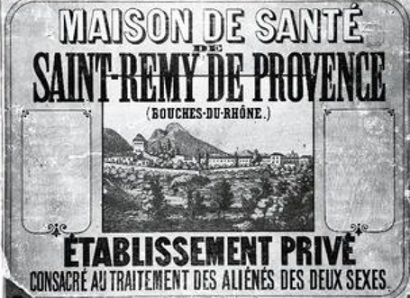
On May 8, 1889, reeling from his deteriorating mental condition, Van Gogh voluntarily committed himself into a psychiatric institution in Saint-Remy, near Arles. As the weeks passed, his mental well-being remained stable and he was allowed to resume painting. This period became one of his most productive. In the year spent at Saint-Remy, Van Gogh created over 100 works, including Starry Night (1889). The clinic and its garden became his main subjects, rendered in the dynamic brushstrokes and lush palettes typical of his mature period. On supervised walks, Van Gogh immersed himself in the experience of the natural surroundings, later recreating from memory the olive and cypress trees, irises, and other flora that populated the clinic's campus.
Shortly after leaving the clinic, Van Gogh moved north to Auvers-sur-Oise outside of Paris, to the care of a homeopathic doctor and amateur artist, Dr. Gachet. The doctor encouraged Van Gogh to paint as part of his recovery, and he happily obliged. He avidly documented his surroundings in Auvers, averaging roughly a painting a day over the last months of his life. However, after Theo disclosed his plan to go into business for himself and explained funds would be short for a while, Van Gogh's depression deepened sharply. On July 27, 1890, he wandered into a nearby wheat field and shot himself in the chest with a revolver. Although Van Gogh managed to struggle back to his room, his wounds were not treated properly and he died in bed two days later. Theo rushed to be at his brother's side during his last hours and reported that his final words were: "The sadness will last forever."
The Legacy of Vincent van Gogh
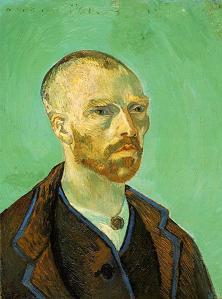
Clear examples of Van Gogh's wide influence can be seen throughout art history. The Fauves and the German Expressionists worked immediately after Van Gogh and adopted his subjective and spiritually inspired use of color. The Abstract Expressionists of the mid-20th century made use of Van Gogh's technique of sweeping, expressive brushstrokes to indicate the artist's psychological and emotional state. Even the Neo-Expressionists of the 1980s, like Julian Schnabel and Eric Fischl, owe a debt to Van Gogh's expressive palette and brushwork. In popular culture, his life has inspired music and numerous films, including Vincente Minelli's Lust for Life (1956), which explores Van Gogh and Gauguin's volatile relationship. In his lifetime, Van Gogh created 900 paintings and made 1,100 drawings and sketches, but only sold one painting during his career. With no children of his own, most of Van Gogh's works were left to brother Theo.
Influences and Connections

-
![Henri de Toulouse-Lautrec]() Henri de Toulouse-Lautrec
Henri de Toulouse-Lautrec -
![Paul Signac]() Paul Signac
Paul Signac ![Theo van Gogh]() Theo van Gogh
Theo van Gogh
-
![Paul Gauguin]() Paul Gauguin
Paul Gauguin -
![Camille Pissarro]() Camille Pissarro
Camille Pissarro ![Albert Aurier]() Albert Aurier
Albert Aurier
Useful Resources on Vincent van Gogh
-
![Simon Schama's Power of Art: Van Gogh]() 83k viewsSimon Schama's Power of Art: Van GoghOur Pick
83k viewsSimon Schama's Power of Art: Van GoghOur Pick -
![Vincent van Gogh Overview]() 0 viewsVincent van Gogh OverviewOur PickGeographical reconstruction of his life in this biographical video
0 viewsVincent van Gogh OverviewOur PickGeographical reconstruction of his life in this biographical video -
![Brief Overview of Van Gogh]() 0 viewsBrief Overview of Van GoghBy Goodbye-Art Academy
0 viewsBrief Overview of Van GoghBy Goodbye-Art Academy
-
![Starry Night - The Unexpected Math]() 8.5M viewsStarry Night - The Unexpected MathOur PickNatalya St. Clair illustrates how Van Gogh captured this deep mystery of movement, fluid and light in his work
8.5M viewsStarry Night - The Unexpected MathOur PickNatalya St. Clair illustrates how Van Gogh captured this deep mystery of movement, fluid and light in his work -
![The Power behind Starry Night]() 13k viewsThe Power behind Starry NightOur PickBy Van Gogh scholar Jared Baxter
13k viewsThe Power behind Starry NightOur PickBy Van Gogh scholar Jared Baxter -
![Sunflower Paintings Documentary]() 52k viewsSunflower Paintings DocumentaryParticular emphasis on forgery of Van Gogh's works, including one version of The Sunflowers
52k viewsSunflower Paintings DocumentaryParticular emphasis on forgery of Van Gogh's works, including one version of The Sunflowers -
![The Bedroom]() 59k viewsThe BedroomTechnical analysis of differences in different paintings in the series. By The Art Institute of Chicago
59k viewsThe BedroomTechnical analysis of differences in different paintings in the series. By The Art Institute of Chicago
-
![Vincent van Gogh: The colour and vitality of his works]() 979k viewsVincent van Gogh: The colour and vitality of his worksOur PickOverview of Van Gogh and some emphasis by curator Colin Wiggins of The National Gallery
979k viewsVincent van Gogh: The colour and vitality of his worksOur PickOverview of Van Gogh and some emphasis by curator Colin Wiggins of The National Gallery -
![Vincent van Gogh and Japan]() 22k viewsVincent van Gogh and JapanOur PickBy Simon Kelly, curator of modern and contemporary art, Saint Louis Art Museum
22k viewsVincent van Gogh and JapanOur PickBy Simon Kelly, curator of modern and contemporary art, Saint Louis Art Museum -
![Van Gogh: Techniques and Methods]() 405k viewsVan Gogh: Techniques and MethodsTechnical analysis of Van Gogh's working style, techniques, and tools by Lydia Vagts, Associate Conservator of Paintings at Museum of Fine Arts, Boston
405k viewsVan Gogh: Techniques and MethodsTechnical analysis of Van Gogh's working style, techniques, and tools by Lydia Vagts, Associate Conservator of Paintings at Museum of Fine Arts, Boston -
![Van Gogh: Sunflowers, Letters & Life]() 56k viewsVan Gogh: Sunflowers, Letters & LifeLucrezia Walker, Freelance Lecturer at the National Gallery, London
56k viewsVan Gogh: Sunflowers, Letters & LifeLucrezia Walker, Freelance Lecturer at the National Gallery, London
 Ask The Art Story AI
Ask The Art Story AI